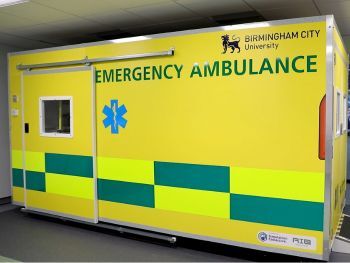University News Last updated 11 September 2024

A purpose-built ambulance simulator will help equip paramedic students at Birmingham City University (BCU) with the skills and confidence to tackle some of the most complex incidents they could ever face – before ever stepping on to the city’s streets.
The ‘simbulance’ is fitted with the latest industry technology and will be used for the first time when term starts in September.
“This technology is a gamechanger in our paramedic training,” said Jodie Byrant, Associate Professor and School Lead for Simulation.
“Often paramedics work in small, confined spaces, so it’s important we train our students in similar settings to assist patients appropriately.
“Students will feel confident enough to make mistakes here rather on the road where consequences would be higher.”
The ‘simbulance’ creates an immersive experience for both paramedic tutors and students.
Funded by Health Education England and built with the help of West Midlands Ambulance Service and Simulation Collective, it also comes equipped with cameras and microphones to allow teaching sessions to be livestreams to larger audiences.
Associate Professor of Paramedic Science Sharon Hardwick added: “The ‘simbulance’ will allow students to take the role of a lead clinician without direct supervision by a lecturer or mentor which will be important in developing student's leadership and self-reliance.”
The ‘simbulance’ is the latest addition to the Professor Carol Doyle Simulation Centre at BCU’s City South Campus in Edgbaston.
The centre already features a resuscitation room, operating theatre, hospital wards, midwifery suite, birthing room and a home environment.
“We want to be able to simulate a patient’s journey and follow their care from start to finish,” added Bryant.
“The addition of the ‘simbulance’ allow us to take a patient that requires the assistance of paramedics and move them around our simulation facility from start to finish.
“It will give students a better and deeper understanding of each stage of a patient’s treatment.”
You can watch the timelapse of how the ambulance simulation was created here.